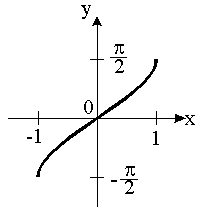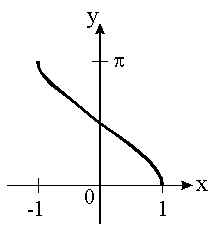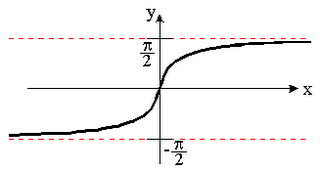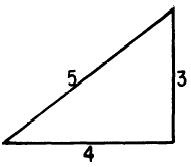4-6: Inverse Trigonometric Relation Graphs
Chapter 4 Section 6: Inverse Trigonometric Relation Graphs
Main Concepts:
Graphs and Principal Branches:
The Definition of arcsin, arctan, and arccos:
Using sine as an example, arcsin x means any of the angles whose sine is x. Arctan and arcos have the same meaning. The problem with this is that the entire graph will not be a function because it does not pass the vertical line test. Therefore, you must take the principal branch of the graph to make it a function. An inverse trigonometric function is a reflection of one branch of the graph across the line y=x. In choosing the principal branch, you must:
1. Include the entire domain
2. Include the origin, or make it as centrally located as possible
3. It must be a function
4. It should be a continuous graph
5. Choose the positive branch if possible
Using sine as an example, arcsin x means any of the angles whose sine is x. Arctan and arcos have the same meaning. The problem with this is that the entire graph will not be a function because it does not pass the vertical line test. Therefore, you must take the principal branch of the graph to make it a function. An inverse trigonometric function is a reflection of one branch of the graph across the line y=x. In choosing the principal branch, you must:
1. Include the entire domain
2. Include the origin, or make it as centrally located as possible
3. It must be a function
4. It should be a continuous graph
5. Choose the positive branch if possible
The Graph of Arcsin: The Graph of Arccos:
The Graph of Arccos: The Graph of Arctan:
The Graph of Arctan:
 The Graph of Arccos:
The Graph of Arccos: The Graph of Arctan:
The Graph of Arctan:
The principal branches of the graphs:
- The Graph of Inverse Sine:
 Keep in mind that the domain of the original sine function becomes the range of its inverse. Domain: [-1, 1]; Range: [o, π]; In reference to the (u,v) coordinate system: Quadrants I and II
Keep in mind that the domain of the original sine function becomes the range of its inverse. Domain: [-1, 1]; Range: [o, π]; In reference to the (u,v) coordinate system: Quadrants I and II
- The Graph of Inverse Cosine:

Domain: [-1, 1]
Range: [-π/2, π/2]
Quadrants I and IV
- The Graph of Inverse Tangent:
Domain: all real numbers
Range: [-π/2, π/2]
Quadrants I and IV
- For the other inverse trigonometric functions:
- Inverse cotangent:
Domain:[-1, 1]; Range: [0, π]; Quadrants I and II
- Inverse secant:
Domain:the absolute value of x ≥ 1; Range: [0, π] and y ≠ π/2; Quadrants I and II
- Inverse cosecant:
Domain:the absolute value of x ≥ 1; Range: [-π/2, π/2] and y ≠ 0; Quadrants I and IV
You can graph inverse trigonometric functions in parametric mode:
x1= sin (T)
y1= T
x2= cos (T)
y2= T
x3= tan (T)
y3= T
This will give you the entire graph of the inverse; even when it is not a function.
When you are in function mode and you graph these, your calculator will give you the graph of a function (like the restricted graphs shown above).
Exact Values of Inverse Circular Functions:
You can geometrically figure these types of problems out by creating a triangle from the given information.
Such as with cos(sin^/1(4/5))
- you can create a 3-4-5 triangle with this information and figure out the cosine of this angle is 3/5
- Sine= opp/hyp, so 4/5 and then you fill in the remaining side. Cosine= adj/hyp, so 3/5
- The Composite of a Function and Its Inverse Function:
f(f^-1(x)) = x and f^-1(f(x)) = x
This holds true only if the "x" is within the range of the outside function and the domain of the inner function.
Example Problem:
Using the concept that we learned about composite functions and their inverse functions:
Remember, f(f^-1(x)) = x and f^-1(f(x)) = x.
Problem:
cos(cos^-1(3/5)) = ?
3/5 is within the range of the outside function and the domain of the inside function, so the answer is 3/5.
For sin(sin^-1(4/5))
the answer is 4/5 because 4/5 is within the range of the outside function and the domain of the inside function.
For sin(sin^-1(5/3))
5/3 is not within the domain of the inside function. The domain of this function is [-1,1] and 5/3 is greater than one. Therefore, sin(sin^-1(5/3)) ≠ 5/3
Link for additional reference: http://www.sparknotes.com/math/precalc/trigonometricfunctions/section4.rhtml
This is my favorite painting...
****Reminder: Debby! You're up again! Good Luck!!!




0 Comments:
Post a Comment
<< Home